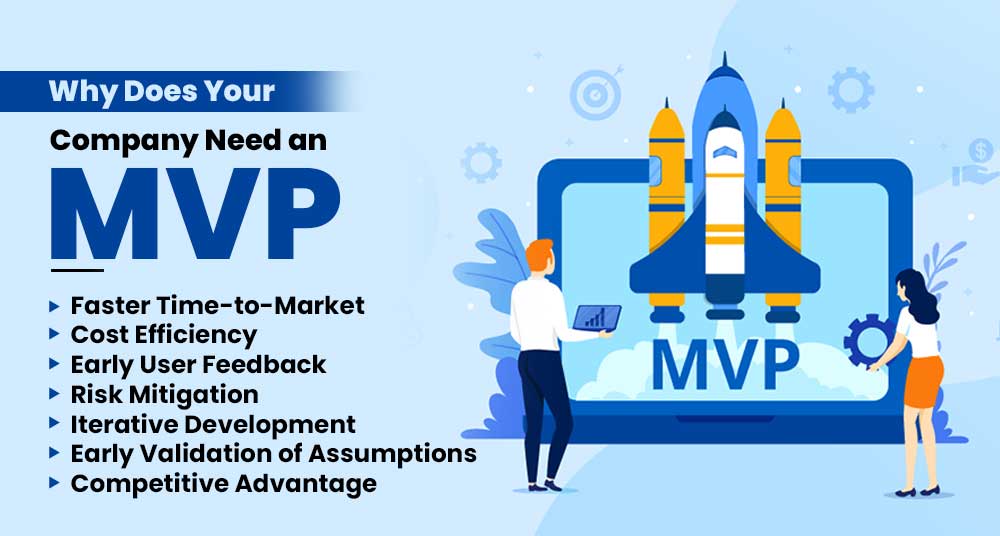Organizations try to maximize the value they give while optimizing their resources in the fast-paced and cost-sensitive world of software development. The Minimum Viable Product (MVP) technique has become potent for increasing cost-effectiveness and success rates in software development projects. The MVP strategy enables organizations to simplify development efforts, decrease complexity, and more effectively manage resources by prioritizing providing a basic product version. What is MPV in software refers to the Minimum Viable Product in software development.
Organizations may gain cost savings in some ways by adopting the MVP method. First, concentrating on providing a few features enables development teams to simplify their work and better manage resources. The MVP strategy pushes the team to identify and prioritize the key elements that satisfy consumers’ immediate requirements and deliver the greatest value rather than spending time and resources building complicated functionality.
Why Implement an MVP Approach into Your Business Model?

The MVP strategy also promotes a culture of prioritization and simplicity. Organizations may prevent scope creep and unneeded complexity by defining and creating minimal feasible features. It minimizes future maintenance and support expenditures as well as development costs. The MVP approach equips businesses with the power to decide where to allocate their funds, ensuring that efforts are focused on the most important features of the final product.
Faster Time-to-Market:
Speed is key to software development success in today’s fast-changing digital environment. Businesses are under pressure to market new products and services rapidly. A useful tactic for shortening the time to market and creating a competitive advantage is the Minimum Viable Product (MVP) approach. The MVP technique enables businesses to accelerate their go-to-market strategy, obtain useful customer input, and quickly iterate on their products by concentrating on producing a basic version of the product with critical functionality.
Organizations may quickly verify their thoughts and ideas in the market using the MVP technique. The emphasis is on creating a minimal set of features highlighting the main value proposition rather than devoting much time and resources to establishing a fully featured solution. Organizations may collect real-world input and verify user requirements and market demand presumptions by releasing the MVP early. This early validation speeds up decision-making and ensures the foundation for the following versions is strong.
The MVP strategy encourages an iterative, agile development process. Prioritizing providing a simple version that satisfies consumers’ fundamental needs is what organizations do instead of aiming for a flawless, feature-rich product before launch. Continuous improvements are possible because of this iterative cycle based on user feedback and shifting market dynamics. Organizations may modify their product roadmaps and iterate on the following versions, ensuring they remain competitive in a fast-paced market by immediately releasing the MVP and gaining feedback.
Cost Efficiency:
A completely functional software product might be expensive to build from scratch. By using the MVP strategy, businesses may design a product with the bare minimum of functionality while saving time and money. Companies can cut costs associated with development, testing, documentation, and maintenance by eliminating extraneous features and components. With less money, entrepreneurs and organizations with tight budgets may more wisely manage their resources thanks to this cost reduction.
Developing a finished product before confirming user acceptability and market demand bears inherent risks. The MVP strategy reduces these risks by enabling businesses to verify their product’s commercial feasibility early. Companies may learn much about the product’s market fit and make wise judgments about additional expenditures by publishing an MVP and soliciting customer input. This risk-mitigation strategy aids in preventing major financial losses linked to producing a product that could fall short of market expectations.
The MVP strategy encourages an iterative development process, enabling businesses to gradually enhance their product in response to customer input and changing market demands. The MVP strategy promotes ongoing iteration and improvement rather than making a significant upfront investment in building a finished product. In addition to reducing costs, this iterative process ensures that the product develops naturally in line with consumer tastes and market trends.
Early User Feedback:
The assumptions established during the product development process are validated by user feedback. It enables businesses to test their concepts, theories, and presumptions with actual customers to ensure the final product meets their wants and expectations.
Early user input allows businesses to enhance the product iteratively. Organizations can uncover usability problems, functional gaps, and other areas for improvement by gathering user input. With the help of this feedback-driven iterative approach, future product versions will solve customer complaints and improve the user experience.
The product-market fit must be determined in part by user input. Organizations may modify their products by studying consumer preferences, pain spots, and desired features to match market needs.
A key component of the MVP in software development is receiving early customer input. It enables businesses to test their hypotheses, iteratively develop their products, find a product-market fit, improve usability and user experience, and increase consumer engagement and loyalty. Organizations may create products that resonate with their intended audience and improve their chances of success in the market by aggressively soliciting and utilizing customer input from the early phases of product development.
Risk Mitigation:
Before spending much money on its development, the MVP strategy enables businesses to test their product in the market. Organizations can monitor user interest, demand, and market reaction by releasing a minimum viable product version. The danger of creating a product that might not satisfy customer wants or run into market opposition is reduced thanks to this early market validation.
The MVP strategy aids organizations in prioritizing risks according to their potential influence on the outcome of the product. Organizations may efficiently allocate resources and handle possible hazards early in development by concentrating on the most important risks.
Iterative Development:
A constant feedback loop between users, stakeholders, and development teams is made possible via iterative development. By publishing an MVP and getting user feedback, businesses may incorporate insightful information into further versions, guaranteeing that the product changes to meet the requirements and expectations of its target audience. Using a feedback-driven design process reduces the chance of creating a product that does not satisfy consumer needs.
In the iterative development process, there is always a chance to test hypotheses and gain knowledge from empirical data. Early product release allows companies to learn more about the product’s market reception, usability, and performance. By identifying and addressing possible problems early, later versions will likely meet user expectations and market needs.
Using iterative development, organizations may adjust and react to shifting needs, user input, and market dynamics. The iterative method acknowledges that requirements change over time rather than attempting to foresee all needs simultaneously. Organizations that value flexibility and adaptability might make changes, add new features, or alter their direction due to the learnings from each cycle.
Early Validation of Assumptions:
Organizations frequently make assumptions during the early phases of software development on their product’s market demand, user needs, preferences, functionality, and usability. These presumptions serve as the development process guiding principles. It is imperative to confirm these assumptions to guarantee that the product satisfies user expectations and is a commercial success.
- Organizations can assess the extent of market demand for their product by releasing an MVP. Organizations can gauge user interest, engagement, and adoption by making the product’s basic version available to a particular demographic. Before spending more money, this validation might assist in identifying whether there is indeed a need and demand for the product.
- Creating a product that appeals to the target market requires making assumptions about the wants and preferences of the consumer. Organizations may get user feedback and insights on their experiences with the product through the MVP. This input aids in validating or improving presumptions about what users desire, enabling businesses to adapt the product to fit their demands.
- The MVP allows you to test your presumptions regarding the fundamental functioning and usability of the product. Organizations can see any usability problems, missing features, or areas that need work by watching how people interact with the MVP. The functionality and user experience of the product is improved through this feedback-driven validation process, ensuring that it meets user expectations.
As a result, the MVP approach’s early validation of hypotheses enables businesses to acquire customer input, improve their product, reduce risks, and maximize budgets and resources. Early assumption validation enables businesses to reduce risks, use resources more efficiently, and produce products that closely meet customer and market wants.
Competitive Advantage:
- Organizations can enter the market early with a working product by releasing an MVP. Organizations using the MVP model can exploit market opportunities and entice early adopters even while competitors may still be in the development stage. Early market entry gives businesses a head start and establishes a presence, giving them a competitive edge.
- The MVP method promotes user participation and input from the beginning of the product development process. Businesses may develop a product that resonates with their target market by including people in the feedback loop and implementing their recommendations. By improving customer pleasure, loyalty, and retention, this user-centric strategy gives organizations an edge over rivals who might not have the same degree of user involvement.
- Because the MVP technique is iterative, businesses can constantly enhance their product based on user input and market research. Organizations may address consumer demands, resolve problems, and improve the features and functioning of the product by incorporating user input into successive iterations. By providing a superior product that changes based on customer preferences and market developments, continuous improvement aids organizations in staying one step ahead of the competition.
- An organization’s reputation may be improved by successfully applying the MVP strategy and providing users with a worthwhile product. Users who are happy with the product and have benefited from the MVP strategy are more inclined to promote it, provide favorable reviews, and tell others about it.
Other Helpful articles-
Top 10 Software Development Trends to Watch in 2024
How to Create a Successful DevOps Roadmap for Software Development in 2023?
Conclusion
MVP (Minimum Viable Product) strategy for developing software projects has several advantages for businesses. Organizations may shorten time to market, cut costs, obtain early customer input, and decrease risks by prioritizing introducing a basic version of the product with key functionality.
Organizations may confirm assumptions, receive insightful consumer feedback, and decide on product development using the MVP technique. Organizations may constantly enhance the product, match it to customer demands, and raise the likelihood of its commercial success by incorporating user feedback into succeeding revisions.
Additionally, the MVP strategy enables businesses to concentrate on providing their product’s core value, ensuring that it efficiently addresses important user concerns and market demands. This emphasis on basic values strengthens the product’s value proposition and differentiates it from rivals.
In general, the MVP method helps businesses to create profitable software products by adopting a user-centric, iterative, and economical strategy. Organizations may improve their competitive advantage, establish product-market fit, and provide high-quality products that satisfy user expectations by using early user input, lowering development costs, and decreasing risks.






What do you think?
It is nice to know your opinion. Leave a comment.